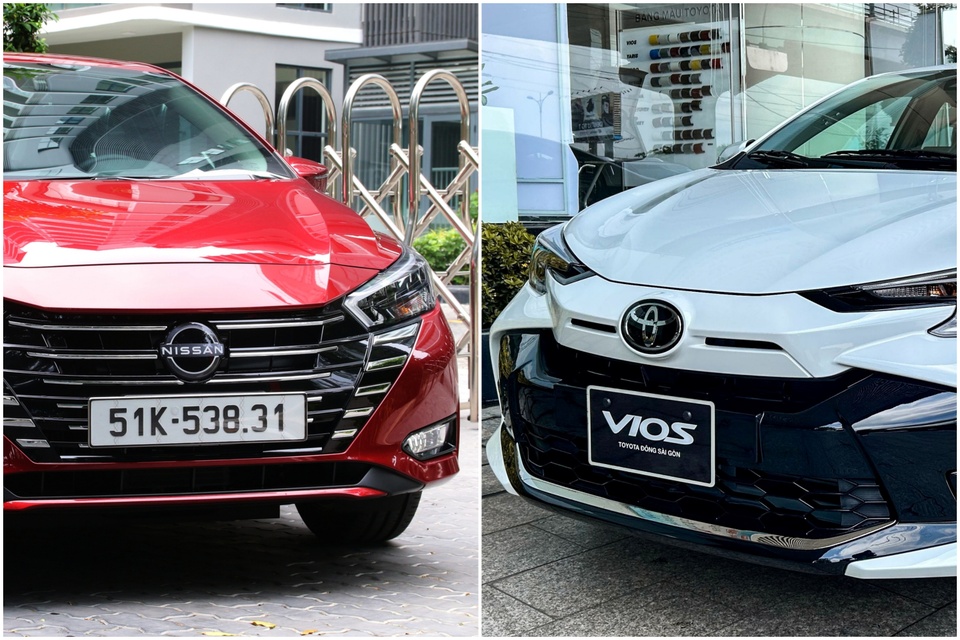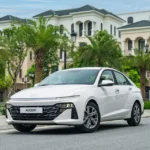
|
Nissan has unveiled the refreshed Almera for the Vietnamese market. The car is still imported from Thailand and is offered in three trim levels: the Almera EL priced at 489 million VND, the Almera V at 529 million VND, and the Almera VL at 569 million VND.
Compared to its predecessors, the Nissan Almera now includes a mid-range option. The starting price of the Almera is also 50 million VND lower, while the top-of-the-line model is 26 million VND more affordable.
The Duo’s Stunning Makeovers
The 2025 Nissan Almera facelift boasts dimensions of 4,495 x 1,740 x 1,455 mm (length x width x height), with a wheelbase of 2,620 mm and a turning radius of 5.2 m.
When compared to the Toyota Vios (4,424 x 1,730 x 1,475 mm), the Almera excels in length and width but falls short in height. The Almera’s wheelbase is slightly longer than the Vios’ 2,550 mm, offering ample legroom for a B-segment sedan from Thailand.
Both the Toyota Vios and Nissan Almera underwent significant changes to their front ends in their most recent updates.
|
|
|
Photo: Phúc Hậu. |
The overall shape of the Almera’s front end retains the signature V-motion design, but the grille has been expanded and is now formed by horizontal silver bars. The 2023 Toyota Vios, on the other hand, sparked quite a controversy with its unique front grille design, a stark departure from its predecessor.
The Toyota Vios comes standard with LED headlights, while the Nissan Almera offers LED headlights only on the V and VL trims, with the base EL trim featuring halogen headlights.
The Nissan Almera offers a standard trunk capacity of 482 liters, slightly less than the Toyota Vios’ 506 liters. For a family car in the B-segment, this specification can play a crucial role in influencing the purchasing decision of Vietnamese car buyers.
Overall, the Nissan Almera’s transformation has garnered more positive feedback compared to the reaction to the Toyota Vios’ upgrade in 2023.
After an initial period of indifference towards the new Toyota Vios, Vietnamese customers are now buying the B-segment sedan in greater numbers, propelling it to the top spot ahead of rivals such as the Hyundai Accent and Honda City in terms of sales as of November.
Comparable Interiors
The cockpit of the 2025 Nissan Almera remains unchanged from its predecessor, featuring a digital instrument cluster combined with a 7-inch screen positioned behind the 3-spoke steering wheel.
The center of the dashboard houses an 8-inch infotainment screen with wireless Apple CarPlay and Android Auto connectivity. However, the placement of the screen in the Almera makes it less visible to the driver.
The 2023 Toyota Vios, on the other hand, received significant upgrades, including a 9-inch floating touchscreen with wireless Apple CarPlay and Android Auto integration, steering wheel-mounted paddle shifters, and a USB-C port for the rear seats.
|
|
|
Photo: Phúc Hậu. |
The Nissan Almera also features a USB port for the rear seats, and the facelifted model now includes armrests for both rows of seats. Similarly, the rear seats of the Toyota Vios are equipped with a center armrest with cup holders.
The legroom for the rear seats in the Nissan Almera measures 620 mm, thanks to the 2,620 mm distance between the two axles, offering one of the most spacious options in its class. The Toyota Vios, with a wheelbase of 2,550 mm, may have a slightly shorter wheelbase, but the difference in comfort between the two models is not significant.
Toyota Vios offers automatic climate control only on the top-of-the-line 1.5G CVT trim, while Nissan Almera includes this feature starting from the mid-range trim.
|
|
|
Photo: Phúc Hậu. |
Both the Toyota Vios and Nissan Almera offer advanced safety technology packages on their highest trims. Toyota’s package is called Toyota Safety Sense, while Nissan’s is known as Nissan Intelligent Mobility.
Some notable features in these ADAS packages include forward collision warning and lane departure warning. The Nissan Almera also includes blind-spot warning, rear cross-traffic alert, adaptive headlights, and a 360-degree camera system.
Overall, the Nissan Almera and Toyota Vios have comparable cabin equipment. While the Toyota Vios may have an edge due to its touchscreen interface, the Nissan Almera counters with superior noise insulation thanks to its acoustic windshield.
Nissan Almera’s Uniqueness vs. Toyota Vios’ Prominence
The refreshed Nissan Almera continues to be powered by a turbocharged 1.0-liter gasoline engine, the only one of its kind in its segment. This engine produces 99 horsepower and 152 Nm of torque.
Under the hood of the Toyota Vios is a naturally aspirated 1.5-liter gasoline engine that generates 106 horsepower and 140 Nm of torque.
While the Toyota Vios has a more powerful engine, the Nissan Almera’s turbocharged engine delivers higher torque, a rare feature in this segment.
|
|
|
The Nissan Almera is the only B-segment sedan in Vietnam to feature a turbocharged 1.0-liter engine. Photo: Phúc Hậu. |
The new Nissan Almera also introduces an Idling Stop feature, resulting in fuel consumption figures of 4.5 liters per 100 km for highway driving and 6.4 liters for city driving. In comparison, the Toyota Vios 1.5G CVT achieves 4.79 liters per 100 km and 7.74 liters per 100 km, respectively.
A brief test drive revealed that the Idling Stop function operates smoothly. After restarting, the Nissan Almera responded promptly as the driver released the brake pedal, moving forward gently without any noticeable jerking.
The test drive was not sufficient to evaluate the accuracy and effectiveness of the Nissan Intelligent Mobility safety features. However, the Nissan Almera’s cabin remained remarkably quiet during the drive, even in the busy streets of Ho Chi Minh City during rush hour.
|
|
|
The top-of-the-line trims of the Toyota Vios and Nissan Almera are both equipped with advanced safety technology packages. Photo: Phúc Hậu. |
Despite the numerous changes and upgrades, the Nissan Almera still faces an uphill battle against the dominant Toyota Vios in the B-segment sedan category. While the price of the new Almera has been reduced compared to its predecessor, the VL trim, the highest-end model, is still 24 million VND more expensive than the Toyota Vios 1.5G CVT.
Currently, the three trims of the Toyota Vios are priced at 458 million VND, 488 million VND, and 545 million VND, respectively. As a result, the starting price of the Nissan Almera (489 million VND) is higher than that of the Toyota Vios 1.5E MT, and the mid-range Almera trim is also more expensive than the Toyota Vios 1.5E CVT.
Nissan Vietnam does not disclose sales figures for the Almera or other Nissan models. However, it is safe to assume that the Almera’s sales volume pales in comparison to the Toyota Vios, which sold 12,706 units in the first 11 months, followed by the Hyundai Accent with 11,677 units and the Honda City with 10,068 units in the same period.
According to a sales consultant at a Nissan dealership, Vietnamese customers have shown a strong interest in the VL trim of the new Almera. However, due to limited stock, most customers will have to wait until after the Tet holiday to take delivery of their vehicles.
Recommended Reads for Your Journey
Our Automotive section offers a diverse range of book recommendations to accompany your travels. Whether you’re embarking on a road trip or simply enjoying a moment of relaxation, these books are sure to enhance your journey.












































